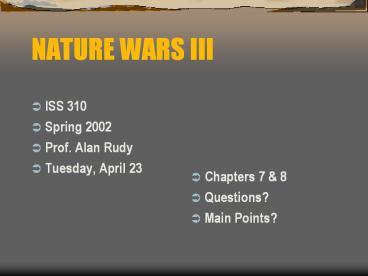NATURE WARS III PowerPoint PPT Presentation
1 / 13
Title: NATURE WARS III
1
NATURE WARS III
- ISS 310
- Spring 2002
- Prof. Alan Rudy
- Tuesday, April 23
- Chapters 7 8
- Questions?
- Main Points?
2
Ch.7 Bees and Other Beneficials
- Moving pollinating bees, not for honey, but to
make fruit and vegetable production possible. - Not necessary until 20th C
- before plenty of species of native bees
coevolved with local plant species and crops
5000 species in N. Am. - Monocropping and pesticides have radically
reduced wild bee populations and necessitated
managed bee industrialization. - Rather than change agriculture to foster and
enhance feral bee populations and activity, we
went with scientific management. -- remember
Vancouver urban planning?
3
Ch.7 Bees and Other Beneficials II
- Only recently have environmentalists begun to
take notice of this kind of environmental
concern. - Keys
- Pesticides
- Monocropping
- Habitat Destruction
- High Managed Bee Populations
- Honey Bee introduced for honey, adapted to
pollination. - Honey Bee populations devastated first by the
European tracheal mite and then the Asian varroa
mite each accidentally introduced.
4
Ch.7 Bees and Other Beneficials III
- Importation/xenotransplanted species often
generate real bad pest problems - PARASITORY AND PREDATORY PEST CONTROL INSECTS
- If there ever was a balance of nature, we have
eliminated it, and much of contemporary
agriculture is designed to restore the balance
through management (122)
5
Ch.7 Bees and Other Beneficials IV
- Imported pests have led to imported pest control
insects. - Imported plant pests have also occurred and done
damage sometimes successfully address with
imported natural biological controls. - Know Winstons account of C.V. Riley, citrus
scale and Australian beetles.
6
Ch.7 Bees and Other Beneficials V
- Greatest experimentation with biological control
from 1900-1945, the pesticides doom most plans by
killing not only pests but also natural killers. - Major natural killers
- wasps
- mites
- nematodes
- fish
- beetles
- bacteria
- fungi
- viruses
7
Ch.7 Bees and Other Beneficials VI
- St. Johns Wort (Klamath weed) infestation treated
successfully with beetles. - Post-WWII DECLINE IN NATURAL ENEMIES RESEARCH
- Rooted largely in pesticide applications often
led to more/new/worse pest outbreaks then before. - No private industry doing this because of limited
profitability also nature takes over while,
with pesticides folks with pest problems always
have to come back to the commercial well
(foreshadowing biotech.) - Only major markets are greenhouses.
8
Ch.7 Bees and Other Beneficials VII
- APPLIED BIO-NOMICS
- Small, elite private business in snooty
retirement area of Vancouver Island. - Issues of complexity of, poorly thought out, and
over-regulation of natural enemies industry. - What we have lost is nature. (139)
9
Ch. 8 FRANKENSTEIN PLANTS
- GMOs mixing and matching genes recombinantly or
transgenically. - who do you trust, scientists, activists, or
regulators (or.) - miracle cures come with a price.
- This stuff IS different than breeders who have to
work with very closely related crops and animals - Natural plant resistance co-evolved with pests
over millenia biotech works in 5 year
increments.
10
Ch. 8 FRANKENSTEIN PLANTS II
- Winston claims close, intensive, and
well-regulated tests indicate that the things
developed so far are pretty safe. - Toxin-producing plants
- Plants with herbicide resistance
- resist herbicide binding.
- overproduce protein herbicide destroys
- produce enzymes to degrade/digest herbicide
- Major public-private collaborations and
competitions for research moneys/patents (newly
legal).
11
Ch. 8 FRANKENSTEIN PLANTS III
- Critics
- human health risks from consumption
- genes jumping from crops to weeds
- increased herbicide use
- accelerated pest resistance
- Regulatory agency strictness but reasonableness
- No labeling of consumption goods.
- Beware allergies one caught already.
12
Ch. 8 FRANKENSTEIN PLANTS IV
- Real worries
- gene jumping
- increased herbicide use
- resistance
- too effective, boom resistance
- whos going to regulate/enforce refuges?
- already happening Bt cotton
- Fred Gould, NCSU
13
CONCLUSION
- HERES THE DEAL
- THERE IS NOT DISCUSSION OF THE SOCIAL
CONSEQUENCES OF THIS TECHNOLOGY (esp. around
TERMINATOR technology). - The only issues are environmental- and
health-related what social consequences of
environmentalism and public health advocacy in
Gary, IN?

